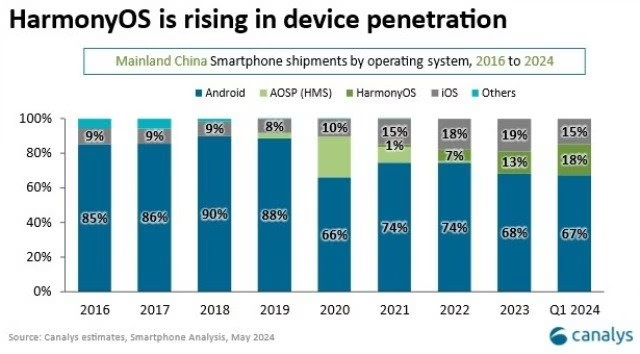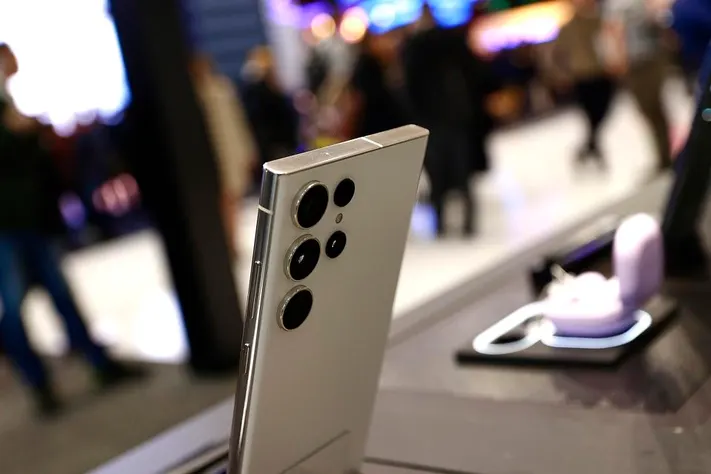Huawei HarmonyOS Hits 103 Million Smartphone Shipments: Analyzing 2024 Growth and Ecosystem Expansion
Estimated reading time: 9 minutes
Key Takeaways
- Huawei’s HarmonyOS achieved a major milestone, shipping *over 103 million* smartphones by the end of 2024.
- The growth was particularly strong in 2024, with approximately *46 million units* shipped in that single year.
- Data from the Canalys report highlights not just smartphone success but also significant HarmonyOS tablet shipments.
- HarmonyOS demonstrated substantial market share growth in 2024, especially in China, surpassing iOS in Q1.
- The HarmonyOS ecosystem is vast, powering over 900 million devices across multiple categories.
- This success is seen as a strategic pivot towards Huawei’s long-term goal of platform independence, spurred by the development of HarmonyOS NEXT.
Table of contents
- Huawei HarmonyOS Hits 103 Million Smartphone Shipments: Analyzing 2024 Growth and Ecosystem Expansion
- Key Takeaways
- The 103 Million Smartphone Shipment Milestone Detailed
- Key Insights from the Canalys Report on HarmonyOS Sales
- Analyzing Huawei HarmonyOS Market Share Growth in 2024
- How Many Devices Run Huawei HarmonyOS Across the Ecosystem
- Focus on Huawei HarmonyOS Tablet Shipments in 2024
- Frequently Asked Questions
In a significant development for the global technology landscape, Huawei’s self-developed operating system, HarmonyOS, has reached a critical milestone. By the end of 2024, Huawei had shipped *over 103 million smartphones* running HarmonyOS. This achievement, representing the much-anticipated huawei harmonyos 100 million smartphone shipments milestone, signals a new era for the company’s software ambitions.

According to data from the Canalys report, which provides detailed insights into huawei harmonyos sales, this figure underscores the rapid expansion and increasing influence of Huawei’s ecosystem. The platform, launched in 2021, was Huawei’s strategic response after losing access to Google’s Android services due to U.S. sanctions (Source: Notebookcheck, SCMP, Mezha.media).
This blog post will delve deeper into this significant achievement, explore the key insights provided by the Canalys report, analyze the remarkable huawei harmonyos market share growth 2024, and examine the broader reach of the HarmonyOS ecosystem, answering the question of how many devices run huawei harmonyos in total.
The 103 Million Smartphone Shipment Milestone Detailed
The headline figure is striking: by the close of 2024, Huawei had successfully shipped 103 million smartphones running its proprietary HarmonyOS. This is the core of the huawei harmonyos 100 million smartphone shipments narrative, exceeding the hundred-million mark and demonstrating substantial progress.

This data is consistently reported across multiple sources, including the prominent Canalys report (Source: Notebookcheck, Nokiamob, SCMP, Mezha.media), underscoring its credibility.
What makes this milestone even more significant is the timeframe and acceleration. Notably, about 45% of these cumulative shipments, which equates to roughly 46 million units, were delivered in 2024 alone. This dramatic surge in a single year highlights the accelerated adoption and increasing popularity of HarmonyOS within Huawei’s device lineup (Source: Notebookcheck, Nokiamob, SCMP, Mezha.media). The rapid pace in 2024 indicates strong market acceptance and successful device launches featuring the OS.

This achievement carries immense historical weight for Huawei. The company initiated the development of HarmonyOS (or HongmengOS in China) as a direct, strategic response to the limitations imposed by U.S. sanctions, which severed its ties with Google Mobile Services and effectively crippled its access to the full Android ecosystem on new devices (Source: Notebookcheck, SCMP, Mezha.media). Launching in 2021, the OS was initially positioned as a platform for various devices, but its deployment on smartphones became a necessity for Huawei’s survival in the mobile market.
Reaching the 103 million milestone is not just a number; it underscores *Huawei’s remarkable resilience* and its tangible progress in building an independent mobile ecosystem. It signifies that HarmonyOS is gaining traction with consumers and developers, moving beyond a contingency plan to become a viable platform in its own right. This figure is a testament to Huawei’s investment in R&D and its ability to leverage its brand loyalty, particularly within its home market.
Key Insights from the Canalys Report on HarmonyOS Sales
The Canalys report huawei harmonyos sales analysis provides a much more comprehensive view than just the smartphone figures. While the 103 million smartphone shipments are the headline, the report offers crucial insights into the broader adoption of HarmonyOS across Huawei’s diverse product portfolio.

Beyond the smartphone success, the Canalys report also shed light on the performance of HarmonyOS on tablets. The report indicates that Huawei shipped a total of 21 million HarmonyOS tablets by the end of 2024 (Learn about tablets here). This figure highlights another significant segment where HarmonyOS is making inroads.
Further breaking down the tablet data, the Canalys report reveals that an impressive *50%* of these tablet sales occurred in 2024 alone (Source: Notebookcheck, Nokiamob, SCMP, Mezha.media). This explicit detail from the Canalys report directly addresses the trend in huawei harmonyos tablet shipments 2024, showing accelerated growth in this category as well.

The analysis from Canalys also points to growing momentum in the PC space. While smartphones and tablets currently lead the HarmonyOS device count, Huawei has been making strategic moves to integrate the OS into its laptop line. Following the expiration of its Microsoft Windows license, Huawei introduced the first HarmonyOS laptops, specifically mentioning models like the MateBook Pro and MateBook Fold (Source: Notebookcheck, SCMP, Mezha.media).
This transition to HarmonyOS on PCs is still in its nascent stages and undeniably faces challenges, particularly concerning legacy software compatibility, where Windows holds decades of dominance. However, this strategic pivot towards HarmonyOS across PCs marks a significant step toward greater platform autonomy for Huawei, according to the Canalys perspective (Source: Notebookcheck, SCMP, Mezha.media). The Canalys report thus paints a picture of HarmonyOS expanding deliberately across Huawei’s hardware portfolio, building a unified experience for users within the Huawei ecosystem.
Analyzing Huawei HarmonyOS Market Share Growth in 2024
Diving deeper into the huawei harmonyos market share growth 2024 reveals a compelling story of ascent, especially within the critical Chinese market. This growth has been particularly pronounced, demonstrating HarmonyOS’s ability to challenge established players.
Specific data points from 2024 underscore this momentum. In the first quarter of 2024, HarmonyOS captured a *significant 17%* share of China’s mobile operating system market (Explore China’s market revival). This was a pivotal moment, positioning HarmonyOS as the *second most popular mobile OS* in the country, notably surpassing Apple’s iOS (Source: Lapaas, Compare OS updates). While Android (primarily AOSP versions used by other manufacturers) remains dominant, HarmonyOS’s climb past iOS in China is a major indicator of its increasing strength and acceptance.

Several key factors contributed to this impressive market share growth in 2024:
- **Strong Domestic Brand Loyalty:** Huawei benefits from immense brand loyalty within China (Compare phone rumors). Chinese consumers have shown a willingness to support domestic technology, especially given the geopolitical context surrounding Huawei.
- **Deep Integration Across Huawei’s Hardware Ecosystem:** HarmonyOS is designed for seamless integration across Huawei devices – smartphones, tablets, wearables, PCs, etc. This connected experience appeals to users heavily invested in the Huawei ecosystem, fostering greater adoption of the OS itself.
- **The Development of HarmonyOS NEXT:** Huawei is actively developing HarmonyOS NEXT, an iteration of the platform specifically designed to be *completely free of the underlying Android Open Source Project (AOSP)*. This move, aimed at furthering software independence, signals Huawei’s long-term commitment to the platform and inspires confidence among users and developers (Source: Lapaas). The prospect of a truly independent OS platform is a major driver.

Analysts view this rapid market share gain as a “watershed moment” in Huawei’s long-term strategy to build a fully self-sufficient hardware-software stack (Source: SCMP). It demonstrates that the company is not just surviving the sanctions but is actively building a competitive alternative ecosystem, starting with a strong base in its home market.
How Many Devices Run Huawei HarmonyOS Across the Ecosystem
While smartphone shipments provide a key metric, understanding the true scale of Huawei’s ambition requires looking at the entire HarmonyOS ecosystem. The question of how many devices run huawei harmonyos across the ecosystem reveals a much larger picture of penetration and influence.
By mid-2024, Huawei reported a staggering figure: *over 900 million active devices* were running HarmonyOS (Source: Lapaas). This number is vastly larger than the smartphone figure alone and illustrates the platform’s reach beyond just mobile phones.

This impressive total count encompasses a wide array of device types, demonstrating the versatility and intended ubiquity of the OS:
- Smartphones (the 103 million discussed)
- Tablets (the 21 million discussed)
- Wearables (smartwatches, fitness trackers)
- Smart TVs
- In-car systems (for connected vehicles)
- Smart home devices (ranging from appliances to IoT gadgets)
This broad penetration across numerous product categories is a core strength of the HarmonyOS strategy. It aims to create a seamless “Super Device” experience where different devices collaborate effortlessly, powered by a unified OS. This multi-device, collaborative vision is what truly sets HarmonyOS apart and is a major factor fueling its widespread adoption across Huawei’s hardware lineup.
This extensive ecosystem is further fueled by the active participation of a large developer community. Huawei reports working with *over 2 million developers* who are building applications and services for HarmonyOS. A vibrant developer community is critical for any operating system’s long-term success, ensuring a continuous stream of new and updated software.
The availability of thousands of native HarmonyOS apps further reinforces the ecosystem’s robustness and highlights the progress in reducing reliance on Android compatibility layers. These native apps are optimized for the HarmonyOS experience, enhancing performance and cross-device utility (Source: Lapaas, Discover productivity apps). The large number of devices running HarmonyOS indicates a strong foundation for future growth and a credible challenge to the dominance of Android and iOS, especially in markets where Huawei maintains a strong hardware presence.
Focus on Huawei HarmonyOS Tablet Shipments in 2024
While smartphones often grab the headlines, the performance of huawei harmonyos tablet shipments 2024 provides another clear indicator of the platform’s expanding success and consumer acceptance beyond its primary mobile device category.

As previously mentioned, data from the Canalys report confirms that by the end of 2024, Huawei had cumulatively shipped 21 million HarmonyOS tablets. This figure itself is substantial, positioning Huawei as a significant player in the tablet market, powered by its own OS.
What is particularly noteworthy is the contribution from 2024. According to the same sources (Source: Notebookcheck, Nokiamob, SCMP, Mezha.media), *half* of those cumulative tablet shipments—translating to an impressive 10.5 million units—were shipped specifically within the calendar year 2024. This represents a rapid pace of adoption in the tablet segment, mirroring the acceleration seen in smartphone shipments.
This aggressive pace in 2024 indicates escalating demand and consumer acceptance of HarmonyOS on larger-screen devices. It suggests that users are not only buying HarmonyOS smartphones but are also comfortable choosing Huawei tablets running the same OS, likely drawn by the promise of a cohesive ecosystem experience.
The tablet segment has benefited from similar factors that propelled the smartphone growth. The tight integration capabilities of HarmonyOS, allowing for seamless connectivity and data flow between Huawei devices, make the tablets particularly appealing to users who own other Huawei products like smartphones or laptops. Furthermore, the ongoing expansion and maturation of the HarmonyOS ecosystem, including the growing availability of apps optimized for tablets, contribute significantly to their attractiveness.
The success in huawei harmonyos tablet shipments 2024 underscores the platform’s viability and growing maturity. It shows that HarmonyOS is proving itself as a capable operating system across different form factors, which is crucial for Huawei’s vision of a connected, multi-device ecosystem.
Frequently Asked Questions
- Q: What is the significance of Huawei reaching 103 million HarmonyOS smartphone shipments?
A: This milestone is highly significant as it demonstrates Huawei’s ability to build a widely adopted mobile operating system independently of Google’s Android, following U.S. sanctions. It signifies consumer acceptance and the platform’s increasing market presence, particularly within China, showing strong progress towards building a self-sufficient software ecosystem.
- Q: Where does the data about the 103 million shipments come from?
A: The figure is widely reported based on data from the Canalys report, a reputable market analysis firm that tracks technology shipments and market share globally and specifically within China.
- Q: How much of the 103 million shipments occurred in 2024?
A: Approximately 45% of the total 103 million HarmonyOS smartphone shipments, amounting to around 46 million units, occurred in 2024 alone. This highlights a rapid acceleration in the platform’s adoption rate in the most recent year.
- Q: Did HarmonyOS surpass iOS in market share in 2024?
A: Yes, in the first quarter of 2024, HarmonyOS captured a 17% share of China’s mobile operating system market, positioning it as the second most popular OS in the country, thereby surpassing Apple’s iOS in that specific quarter.
- Q: How many total devices run Huawei HarmonyOS across the entire ecosystem?
A: Beyond smartphones, HarmonyOS powers a much larger ecosystem. By mid-2024, Huawei reported over 900 million active devices running HarmonyOS, including smartphones, tablets, wearables, TVs, in-car systems, and smart home devices.
- Q: What are the trends for Huawei HarmonyOS tablet shipments in 2024?
A: According to the Canalys report, Huawei had shipped a total of 21 million HarmonyOS tablets by the end of 2024. Notably, half of these shipments (10.5 million units) occurred within 2024, indicating strong and accelerating growth in the tablet segment for the platform.
- Q: What is HarmonyOS NEXT and why is it important?
A: HarmonyOS NEXT is an upcoming version of the platform that will be entirely independent of the Android Open Source Project (AOSP). It’s important because it represents Huawei’s commitment to creating a truly distinct and self-sufficient operating system, furthering its goal of platform autonomy and reducing reliance on any foreign technology components.
- Q: How is the developer community supporting HarmonyOS growth?
A: Huawei reports a large and growing developer community, with over 2 million developers actively building for HarmonyOS. This large developer base is crucial for increasing the number and quality of native HarmonyOS applications, which in turn enhances the user experience and drives further adoption across the ecosystem.
- Q: Does HarmonyOS pose a global challenge to Android and iOS?
A: While HarmonyOS currently has its strongest foothold in China, its rapid growth, expanding ecosystem across various device types, and strategic development of AOSP-free versions like HarmonyOS NEXT indicate its potential to become a significant global alternative in the long term, particularly as Huawei continues to innovate and expand its hardware presence internationally.
- Q: How do U.S. sanctions relate to the development and success of HarmonyOS?
A: U.S. sanctions, which led to Huawei losing access to Google Mobile Services and crippled its ability to use standard Android on new devices, were the primary catalyst for Huawei accelerating the development and deployment of HarmonyOS on smartphones. The platform’s success is therefore directly linked to Huawei’s strategic response to these restrictions, turning a challenge into an opportunity to build an independent ecosystem.






